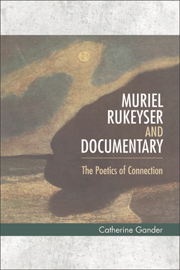5 - Landscape, Navigation and Cartography
Published online by Cambridge University Press: 05 August 2013
Summary
Exploring and documenting the American landscape, topologically and historically, remained a priority for Rukeyser throughout her working life. By examining the ways in which Rukeyser became involved with and manipulated the forms and techniques of travel reportage and tour guiding – two closely related documentary genres that developed during the 1930s and pervaded writing and image-making well into the 1940s – this chapter will illustrate how she pioneered a poetic cartography that provided witness to both the past and the present.
Throughout the chapter, I refer to Rukeyser's visualisation and utilisation of the landscape as site of ‘cultural practice’. In using this terminology, I have drawn upon W. J. T. Mitchell's ideas in Landscape and Power. Starting from the premise first stated by Raymond Williams that ‘a working country is hardly ever a landscape,’ Mitchell asks that landscape be considered ‘not as an object to be seen or a text to be read, but as a process by which social and subjective identities are formed’. His critique relies on both Marxist and phenomenological discourses, and by understanding landscape as both ‘an instrument of cultural power’ and as marketable, habitable, workable ‘space’, he constructs the argument that ‘landscape is a dynamic medium’. In what follows, I hope to demonstrate the ways in which Rukeyser's poetry figures the landscape as a ‘process’ of personal and social identification and as a site of cultural practice.
- Type
- Chapter
- Information
- Muriel Rukeyser and DocumentaryThe Poetics of Connection, pp. 167 - 207Publisher: Edinburgh University PressPrint publication year: 2013

